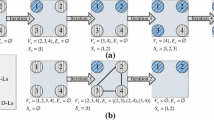Abstract
This paper considers the power allocation problem in device-to-device (D2D) communication underlaying a cellular network and investigates the impact of different transmitting and interference power constraints on the energy efficiency and spectral efficiency of the network. We formulate the power allocation problem in D2D communication as a nonlinear fractional programming problem with an objective to maximize the energy efficiency of a D2D communication link subject to four different combinations of transmitting and interference power constraints. To solve the original formulated nonlinear fractional programming problem, we first convert it into a dual nonlinear parametric programming problem, and then decouple the dual problem into several solvable concave problems. Further, a closed-form solution is derived to each dual problem and an efficient power allocation algorithm is proposed to find a numerical solution to the formulated problem. Simulation results show that the proposed power allocation algorithm outperforms an ergodic capacity maximization algorithm and a uniform power distribution algorithm in terms of the energy efficiency of a D2D link, and can efficiently improve the overall ergodic capacity of a cellular network.






Similar content being viewed by others
References
Gandotra P, Jha R, Jain S (2017) Green communication in next generation cellular networks: a survey. IEEE Access 5(6):11727–11758
David K, Berndt H (2018) 6G vision and requirements: is there any need for beyond 5G. IEEE Veh Technol Mag 13(3):72–80
Klaiqi B, Chu X, Zhang J (2018) Energy-and spectral-efficient adaptive forwarding strategy for multi-hop device-to-device communications overlaying cellular networks. IEEE Wireless Commun 17(9):5684–5699
Wang J, Zhu D, Zhao C, et al. (2013) Resource sharing of underlaying device-to-device and uplink cellular communications. IEEE Commun Lett 17(6):1148–1151
Zheng J, Chen R, Zhang Y (2015) Dynamic resource allocation based on service time prediction for device-to-device communication underlaying cellular networks. IET Commun 9(3):350–358
Nguyen HH, Hasegawa M, Hwang WJ (2016) Distributed resource allocation for D2D communications underlay cellular networks. IEEE Commun Lett 20(5):942–945
Zhu D, Wang J, Swindlehurst AL, et al. (2014) Downlink resource reuse for device-to-device communications underlaying cellular networks. IEEE Signal Process Lett 21(5):531–534
Liu C, Zheng J (2017) A QoS-aware resource allocation algorithm for device-to-device communication underlaying cellular networks. Proc. of IEEE VTC 2017-Spring, Sydney, Australia
Dominic S, Jacob L (2018) Distributed resource allocation for D2D communications underlaying cellular networks in time-varying environment. IEEE Commun Lett 22(2):388–391
Xu H, Xu W, Yang Z, et al. (2017) Energy-efficient resource allocation in D2D underlaid cellular uplinks. IEEE Commun Lett 21(3):560–563
Wu D, Wang J, Hu RQ, et al. (2014) Energy-efficient resource sharing for mobile device-to-device multimedia communications. IEEE Trans Veh Technol 63(5):2093–2103
Zheng J, Liu C, Chu L (2018) BARA: a battery energy and data rate aware resource allocation algorithm for QoE in D2D Communication underlaying Cellular Networks. Proc. of IEEE ICC’18, Kansas City, USA
Hu J, Heng W, Li X, et al. (2017) Energy-efficient resource reuse scheme for D2D communications underlaying cellular networks. IEEE Commun Lett 21(9):2097–210
Zhang R, Cui S, Liang YC (2009) On ergodic sum capacity of fading cognitive multiple-access and broadcast channels. IEEE Trans Inform Theory 55(11):5161–5178
Dinkelbach W (1967) On nonlinear fractional programming. Manag Sci 13(7):492–498
Boyd S, Vandenberghe L (2004) Convex optimization. 5th. Cambridge University Press, Cambridge U.K
Acknowledgements
This work was supported in part by the National Science and Technology Projects of China under grant 2018ZX03001002, in part by the NSFC under grants 61601115, 61871108, and 61971130, and in part by the Natural Science Foundation of Jiangsu Province under Grant BK20160069.
Author information
Authors and Affiliations
Corresponding author
Additional information
Publisher’s Note
Springer Nature remains neutral with regard to jurisdictional claims in published maps and institutional affiliations.
Rights and permissions
About this article
Cite this article
Shi, F., Chen, R., Shen, H. et al. Energy-Efficient Power Allocation for D2D Communication underlaying Cellular Networks. Mobile Netw Appl 27, 483–491 (2022). https://doi.org/10.1007/s11036-020-01692-3
Accepted:
Published:
Issue Date:
DOI: https://doi.org/10.1007/s11036-020-01692-3




